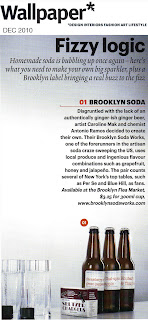The flavours they have concocted include:By day, Antonio Ramos is a medicinal chemist at the drug maker Sanofi-Aventis in Bridgewater, N.J., where he helps develop molecules for prescription drugs. In the evening, he puts his chemistry skill set to a different use: developing formulas for Brooklyn Soda Works, the artisanal soda company he started last year with his partner, Caroline Mak.
A Chemist, an Artist and a Lot of Fizz
- cucumber, lime & sea salt
- grapefruit, jalapeno & honey
- apple & ginger
- Concord grape & fennel seed
- strawberry, hops & pink peppercorn
- raspberry & green peppercorn
You can follow their progress and experiments with new flavours through their blog:
Brooklyn Soda Works
Making your own unusual sodas is as easy as getting a soda siphon and some juice! You can buy the siphons and cartridges of CO2 at many cooking stores or online.
You can also make fizzy drinks using baking soda:
But what if you didn’t have the money to buy soft drinks? What then? Believe it or not, people used to make their own soft drinks! Yep, right at home in their kitchens. Mostly, it was lemonade or limeade, or other fizzy or sweet drinks made from the juice of various citrius fruits. You took lemon-juice, sugar, water and baking-soda (that’s Bicarbonate of Soda or Sodium Bicarbonate) and mixed the ingredients in correct quantities. You left the mixture to stand for a while, to give the baking-soda time to react with the lemon-juice and the other ingredients, the result being that it fizzed up, to create fizzy lemonade. You can still make homemade lemonade like this, and recipes are available on the internet. Some substitute the baking-soda and water for soda-water instead, but the results are all similar. Fizzy, sweet, lemon-flavoured goodness on a hot summer’s day.

No comments:
Post a Comment
Comments, corrections, or criticisms...